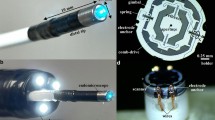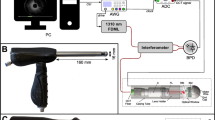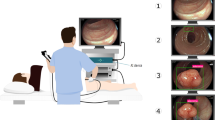Abstract
Recent studies on a novel technology, denoted confocal laser endomicroscopy (CLE), have altered thinking about the possibilities of endoscopy in the diagnosis and treatment of colorectal cancer. CLE is a new endoscopic tool that allows in vivo histology at subcellular resolution during ongoing endoscopy, and permits subsurface imaging of normal and neoplastic human mucosa. This new technique has unequivocal major implications for the diagnosis and clinical management of patients scheduled for screening or surveillance colonoscopy for colorectal cancer. For instance, CLE allows immediate diagnosis of colonic neoplasias, and the detection of neoplastic cells helps to target endoscopic intervention to relevant areas. Furthermore, the combination of chromoendoscopy with CLE significantly decreases the number of biopsies required for cancer surveillance in patients with ulcerative colitis, but provides a fourfold higher diagnostic yield compared with white-light endoscopy used with random biopsies. Taken together, CLE has led colorectal cancer endoscopy into a new era. CLE can no longer be regarded as just another endoscopic technique, but emerges as a crucial novel imaging technique for in vivo diagnosis of colorectal cancer.
Key Points
-
Confocal laser endomicroscopy is a new diagnostic tool allowing in vivo microscopy at subcellular resolution during ongoing endoscopy
-
Endomicroscopy can be used to immediately diagnose colorectal cancer or intraepithelial neoplasia
-
Endomicroscopy allows biopsies to be targeted to microscopic suspicious areas, leading to a substantial reduction in the number of conventional biopsies
-
The combination of chromoendoscopy and endomicroscopy improves the diagnostic yield of intraepithelial neoplasias in patients with long-standing ulcerative colitis
This is a preview of subscription content, access via your institution
Access options
Subscribe to this journal
Receive 12 print issues and online access
$209.00 per year
only $17.42 per issue
Buy this article
- Purchase on Springer Link
- Instant access to full article PDF
Prices may be subject to local taxes which are calculated during checkout








Similar content being viewed by others
References
Grady WM (2003) Genetic testing for high-risk colon cancer patients. Gastroenterology 124: 1574–1594
Burt RW (2000) Colon cancer screening. Gastroenterology 119: 837–853
Gatta G et al. (2003) Differences in colorectal cancer survival between European and US populations: the importance of sub-site and morphology. Eur J Cancer 39: 2214–2222
Weir HK et al. (2003) Annual report to the nation on the status of cancer, 1975-2000, featuring the uses of surveillance data for cancer prevention and control. J Natl Cancer Inst 95: 1276–1299
Chung DC (2000) The genetic basis of colorectal cancer: insights into critical pathways of tumor genesis. Gastroenterology 119: 854–865
Winawer S et al. (2003) Colorectal cancer screening and surveillance: clinical guidelines and rationale—update based on new evidence. Gastroenterology 124: 544–560
Schulmann K et al. (2002) Colonic cancer and polyps. Best Pract Res Clin Gastroenterol 16: 91–114
Kiesslich R and Neurath MF (2006) Chromoendoscopy and other novel imaging techniques. Gastroenterol Clin North Am 35: 605–619
Machida H et al. (2004) Narrow-band imaging in the diagnosis of colorectal mucosal lesions: a pilot study. Endoscopy 36: 1094–1098
Kiesslich R et al. (2004) Confocal laser endoscopy for diagnosing intraepithelial neoplasias and colorectal cancer in vivo. Gastroenterology 127: 706–713
Helmchen F (2002) Miniaturization of fluorescence microscopes using fibre optics. Exp Physiol 87: 738–745
Robinson JP (2000) Principles of confocal microscopy. Methods Cell Biol 63: 89–106
Conchello JA and Lichtman JW (2005) Optical sectioning microscopy. Nat Methods 2: 920–931
Delaney PM et al. (1994) Fibre optic confocal imaging (FOCI) for subsurface microscopy of the colon in vivo. J Anat 184: 157–160
Karadaglic D et al. (2002) Confocal endoscopy via structured illumination. Scanning 24: 301–304
Helmchen F (2002) Miniaturization of fluorescence microscopes using fibre optics. Exp Physiol 87: 737–745
Evans JA and Nishioka NS (2005) Endoscopic confocal microscopy. Curr Opin Gastroenterol 21: 578–584
Inoue H et al. (2005) Technology Insight: laser scanning confocal microscopy and endocytoscopy for cellular observation of the gastrointestinal tract. Nat Clin Pract Gastroenterol Hepatol 2: 31–37
Sakashita M et al. (2003) Virtual histology of colorectal lesions using laser-scanning confocal microscopy. Endoscopy 35: 1033–1038
Yoshida S et al.: Optical biopsy of gastrointestinal lesions by reflectance-type laser-scanning confocal microscopy. Gastrointestinal Endoscopy, in press
Kiesslich R et al. (2006) In vivo histology of Barrett's esophagus and associated neoplasia by confocal laser endomicroscopy. Clin Gastroenterol Hepatol 4: 979–987
Kiesslich R et al. (2005) Diagnosing Helicobacter pylori in vivo by confocal laser endoscopy. Gastroenterology 128: 2119–2123
Kakeji Y et al. (2006) Development and assessment of morphologic criteria for diagnosing gastric cancer using confocal endomicroscopy: an ex vivo and in vivo study. Endoscopy 38: 886–890
Kitabatake S et al. (2006) Confocal endomicroscopy for the diagnosis of gastric cancer in vivo. Endoscopy 38: 1110–1114
Kiesslich R et al. (2007) Chromoscopy-guided endomicroscopy increases the diagnostic yield of intraepithelial neoplasia in ulcerative colitis. Gastroenterology 132: 874–882
Kiesslich R et al. (2006) In vivo diagnosis of collagenous colitis by confocal endomicroscopy. Gut 55: 591–592
Polglase AL et al. (2005) A fluorescence confocal endomicroscope for in vivo microscopy of the upper- and the lower-GI tract. Gastrointest Endosc 62: 686–695
Kiesslich R et al. (2005) Confocal laser endomicroscopy. Gastrointest Endosc Clin N Am 15: 715–731
Inoue H et al. (2003) Development of virtual histology and virtual biopsy using laser-scanning confocal microscopy. Scand J Gastroenterol Suppl 237: 37–39
Kiesslich R et al. (2003) Methylene blue-aided chromoendoscopy for the detection of intraepithelial neoplasia and colon cancer in ulcerative colitis. Gastroenterology 124: 880–888
Rutter MD et al. (2004) Pancolonic indigo carmine dye spraying for the detection of dysplasia in ulcerative colitis. Gut 53: 256–260
Hurlstone DP et al. (2005) Indigo carmine-assisted high-magnification chromoendoscopic colonoscopy for the detection and characterisation of intraepithelial neoplasia in ulcerative colitis: a prospective evaluation. Endoscopy 12: 1186–1192
Kiesslich R and Neurath MF (2004) Surveillance colonoscopy in ulcerative colitis: magnifying chromoendoscopy in the spotlight. Gut 53: 165–167
Goetz M et al. (2007) In vivo confocal real time mini-microscopy in animal models of human inflammatory and neoplastic diseases. Endoscopy 39: 350–356
Author information
Authors and Affiliations
Corresponding author
Ethics declarations
Competing interests
Ralf Kiesslich and Markus F Neurath have received an unrestricted grant from Pentax Europe and M Vieth has been on a speaker's bureau for Pentax Europe. The other authors declared no competing interests.
Rights and permissions
About this article
Cite this article
Kiesslich, R., Goetz, M., Vieth, M. et al. Technology Insight: confocal laser endoscopy for in vivo diagnosis of colorectal cancer. Nat Rev Clin Oncol 4, 480–490 (2007). https://doi.org/10.1038/ncponc0881
Received:
Accepted:
Issue Date:
DOI: https://doi.org/10.1038/ncponc0881
This article is cited by
-
Flexible-type ultrathin holographic endoscope for microscopic imaging of unstained biological tissues
Nature Communications (2022)
-
Lissajous Scanning Two-photon Endomicroscope for In vivo Tissue Imaging
Scientific Reports (2019)
-
Nonlinear optical endomicroscopy for label-free functional histology in vivo
Light: Science & Applications (2017)
-
Microscopic imaging in endoscopy: endomicroscopy and endocytoscopy
Nature Reviews Gastroenterology & Hepatology (2014)
-
In vivo imaging using fluorescent antibodies to tumor necrosis factor predicts therapeutic response in Crohn's disease
Nature Medicine (2014)



